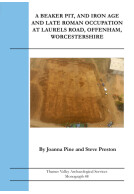Google Books previews are unavailable because you have chosen to turn off third party cookies for enhanced content. Visit our cookies page to review your cookie settings.
Charnham Lane, Hungerford, Berkshire (Paperback)
Imprint: Thames Valley Archaeological Services
Series: TVAS Monograph Series
Pages: 87
ISBN: 9780954400606
Published: 25th June 2002
Script Academic & Professional
Series: TVAS Monograph Series
Pages: 87
ISBN: 9780954400606
Published: 25th June 2002
Script Academic & Professional
Usually available in 6-8 weeks.
You'll be £10.00 closer to your next £10.00 credit when you purchase Charnham Lane, Hungerford, Berkshire. What's this?
+£4.99 UK Delivery or free UK delivery if order is over £40
(click here for international delivery rates)
Order within the next 2 hours, 4 minutes to get your order processed the next working day!
Need a currency converter? Check XE.com for live rates
(click here for international delivery rates)
Order within the next 2 hours, 4 minutes to get your order processed the next working day!
Need a currency converter? Check XE.com for live rates
The first volume in the series details the evidence of a long, if intermittent human exploitation of this floodplain landscape.
Although a few Upper Palaeolithic/Early Mesolithic flints were found, the earliest securely dated features were later Mesolithic fire pits, which contained charred plant remains, suggesting they were used for cooking. Other concentrations of late Mesolithic flintwork came from surface collection, both on the floodplain and on a gravel 'island' rising above it.
Early Bronze Age finds include three components: a pit circle, an adjacent occupation area, and detailed environmental evidence derived from a pollen sequence indicating, for example, that woodland clearance did not begin until the early Bronze Age.
There is then a lengthy gap in the use of the area until a small settlement was created in Saxon times. Most of the structures and deposits on the site, however, were medieval. A bi-focal settlement seems to be indicated, most probably neighbouring farms, created in the 11th-12th centuries and lasting until an abandonment probably in the 14th century. Although finds of this period were not abundant, environmental evidence allows a reconstruction of a mixed farming economy.
Other titles in the series...
Other titles in Thames Valley Archaeological Services...










